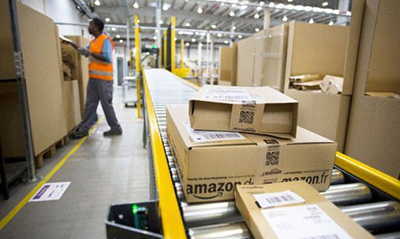Report says Amazon is focusing on building out delivery trial offering
A Bloomberg indicated that Amazon has expanded the Seller Flex service, which Amazon has renamed to FBA Onsite.

Last fall, Bloomberg reported that Amazon was working on a new delivery offering geared towards making more products available for free two-day delivery while helping to relieve overcrowded warehouses, with this initiative driving the global e-commerce power into services typically handled for Amazon by UPS and FedEx.
The report, which was published in October, explained that Amazon first began work on this service, entitled Seller Flex, in India in 2015 and subsequently “slowly marketing” it to United States-based merchants with an eye on a national expansion. And it noted that its U.S. launch kicked off on the West Coast earlier last year, which is expected to be followed with what the report called a broader rollout.
In terms of how Seller Flex works, Bloomberg said that Amazon will oversee package pickups from the warehouses of third-party merchants selling goods through Amazon.com and delivery to customers’ homes. These tasks are currently handled for Amazon by UPS and FedEx. And while Amazon may still use UPS and FedEx for delivery, the report said that Amazon will decide how to send a package, as opposed to leaving that at the discretion of the seller.
Among the benefits of handling more deliveries for Amazon, cited in the report, are things like providing greater flexibility and control over the last mile to consumer’s homes, saving money through volume discounts, and helping to avoid congestion in Amazon warehouses through keeping merchandise in outside sellers’ facilities. Other noted benefits include how Seller Flex would provide Amazon with more flexibility into warehousing and delivery operations of merchant partners, with the potential of making full use of their product inventory, storage, space, and customer proximity with a quick delivery guarantee.
A separate Bloomberg report, which was published today, indicated that Amazon has expanded the Seller Flex service, which Amazon has renamed to FBA Onsite.
The report explained that along with changing the name of the offering, Amazon is recruiting more sellers and telling merchants they can keep goods in their own warehouses, as in the past merchants had to send goods to Amazon facilities and then pay extra fees to participate in FBA Onsite, as well as Amazon’s household goods fulfillment service called Subscribe and Save that offers discounts on frequently purchased items.
Among the benefits of FBA Onsite cited in the report were: increasing inventory; shortening delivery times; reducing costs; and letting merchants send inventory to Amazon warehouses and pay Amazon to handle storage, packing and deliver.
FBA Onsite is interesting from a delivery and distribution on a few different levels, according to Jerry Hempstead, president of Hempstead Consulting, in a recent interview.
“It's for retailers that peddle their products on the Amazon site. So in some situations, dependent on volume, of course, it’s more efficient to pick up some packages I think they are looking at regional footprints) and inject the volumes directly,” he said. This is in lieu of moving volume from retailer to Amazon fulfillment and then from Amazon fulfillment to consumer. This next logical step can reduce mileage on a piece of inventory, reduce handling, and reduce time to consumer gratification.”
As for the potential impact of FBA Onsite on UPS and FedEx, Hempstead said it is not perceived as a “huge threat,” saying it is more of a logical nuance. And he noted that some retailers that use Amazon to sell their items select their own carrier today but are required to meet Amazon’s delivery requirements and some of that business may be subject to diversion away from the integrators.
“I think this new offering will be limited in clientele and delivery footprint,” said Hempstead.
A research note issued last fall by Baird and Co. analyst Colin Sebastian said that Amazon’s final-mile efforts reflect a logical extension to its model as it builds network density, justifying incremental insourcing of purchased transportation spend, as well as ongoing efforts to continue managing rising costs in its final-mile delivery network.
In recent years, Amazon has been diligent in expanding its own logistics network in the form of things like opening 20 regional sort centers and launching its own air network contracting with ATSG and Atlas Airlines. Other logistics-related efforts of note by Amazon include things like testing drone delivery of parcels, and building an Uber-like app for freight, among others.

Article Topics
Latest in Logistics
Cass Freight Index points to annual shipments and expenditures declines ALAN opens up its nominations for 2024 Humanitarian Logistics Awards U.S.-bound import growth remains intact in April, reports Descartes Looking at a reshoring history lesson NTSB: Ship lost power twice before slamming into Baltimore bridge, closing port ISM May Semiannual Report points to growth in 2024, at a reduced rate April retail sales are mixed, reports Commerce and NRF More LogisticsAbout the Author
Subscribe to Logistics Management Magazine

Find out what the world's most innovative companies are doing to improve productivity in their plants and distribution centers.
Start your FREE subscription today.
May 2024 Logistics Management

Latest Resources














